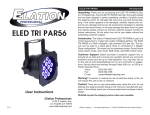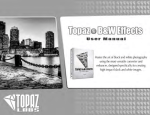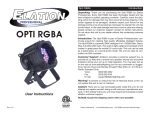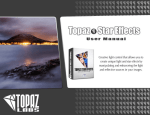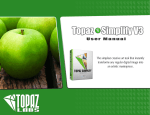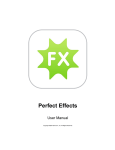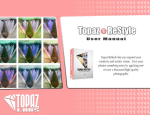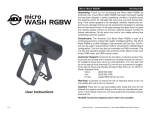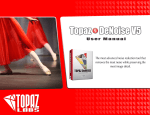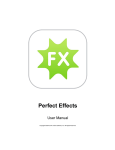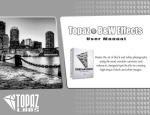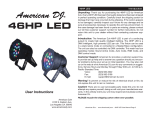Download User Manual - Topaz Labs
Transcript
Contents Topaz Simplify User Manual I. Installation A. How to Install B. Host-Specific Installation D. Uninstalling .3 4 .6 II. Introduction A. Topaz Simplify 1. About Topaz Simplify 2. Primary Functions B. New Features 7 7 7 9 III. Work Area A. Interface B. Preview C. Presets 1. Applying Presets 2. Adding Presets 3. Deleting Presets 4. Importing Presets 5. Exporting Presets 6. Sharing Presets D. Tools E. Menu 1. Preferences 2. Check for Update 3. Enter Key 4. What’s This? 5. Tech Support 6. Product Info 7. Gallery 8. MyTopaz 9.Tutorials 10.About .9 13 15 15 15 16 17 17 17 18 19 19 20 20 20 20 20 .21 .21 21 21 IV. Settings & Parameters A. Effects & Presets..............................................22 B. Parameters.......................................................22 C. Global Adjustments.........................................23 1. Simplify Mode.........................................23 2. Simplify...................................................24 3. Adjust......................................................25 4. Edges......................................................26 5. Curve Tool...............................................27 D. Local Adjustments..........................................28 E. Finishing Touches............................................29 1. Transparency.............................................29 2. Vignette.....................................................29 3. Tone...........................................................30 VI. Work Flow A. Sample Project #1 B. Sample Project #2 .31 38 VII. Additional Resources A. Glossary B. FAQ’s C. Shortcut Keys D. Connect E. Company Info .45 47 .49 .50 .51 2 Topaz Simplify User Manual Installation The Topaz Software Manager is the new host for your Topaz installations. You will be able to easily access your downloads, updates to Topaz Simplify from this host. Before you install the Topaz Software Manager, please close all applications, including Photoshop, Photoshop Elements, Lightroom, iPhoto, Aperture, etc. Please do not open any other applications during the installation process. To Begin Installing the Software Manager Double-click on the installation file provided from your download from the Topaz Labs website. A window will appear displaying the Topaz Software Manager setup wizard. Then you will choose either 32-bit and/or 64-bit installation of Simplify. Once you have made your selections click ‘Start Installations’. It will go through a 9-part installation process and once it is finished you may exit the Topaz Software Manager. Important for Mac Users After installation, Simplify 4 will be installed in the following folder: “ Applications->Topaz Labs -> Topaz Simplify 4”. The Installer will walk you through the process. After you have read the Read Me and accepted the End User License Agreement, your installation will be completed and you can close the Wizard. The Software Manager will then launch and you will need to click ‘Install Topaz Labs plugin(s) not currently installed on this computer, and then ‘Next’. Important for PC Users After installation, Simplify 4 will be installed in the following folder: “C:\ ->Program Files (x86) ->Topaz Labs -> Applications -> 32-bit/64-bit -> Topaz Simplify 4”. 3 Topaz Simplify User Manual Please see below on how to properly install into Photoshop, Photoshop Elements, Lightroom, Aperture, and iPhoto. Photoshop and Photoshop Elements When your installer is complete it should automatically install in to your Filters tab under Topaz Labs->Simplify 4 . If you can’t see Simplify 4 after you quit and restart Photoshop, try the following: For Mac : Go to Applications -> Topaz Labs -> Topaz Labs Plug-ins -> and copy and paste the Topaz_simplify4.plugin file to your Photoshop Plug-Ins folder. This is usually located in Applications -> Adobe Photoshop -> Plug-Ins. Delete the Simplify 4 shortcut already in that folder, if there is one. Restart Photoshop and you’ll see it in the Filters menu. For Windows: Go to C:\Programs Files (x86) -> Topaz Labs -> Applications -> 32-bit/64-bit -> Topaz Plugins -> copy and paste the tlsimplify4ps.8bf file into your Photoshop Plug-Ins folder. This is usually located in C:\Program Files -> Adobe -> Adobe Photoshop -> Plug-Ins. Delete the Simplify 4 shortcut already in that folder, if there is one. Restart Photoshop and you’ll see it in the Filters menu. Installation Lightroom To use Simplify 4 in Lightroom you will need to go through Topaz Fusion Express. Fusion Express will be automatically downloaded with Simplify 4. Fusion Express should automatically be listed as a preset within Lightroom. If you would like to use Fusion Express as your external editor, please see the setup instructions below. For Mac: 1) Go to “Lightroom -> Preferences … -> External Editing”, in the Additional External Editor panel, choose Fusion Express (located in “Applications -> Topaz Labs -> Fusion Express”) as the external editor 2) Select TIFF in File Format pull-down menu 3) Select the Color Space choice and Bit Depth. It is recommended to use 16-bit ProPhoto RGB for Color Space for best preserving of color details from Lightroom. For Windows: Open Lightroom (if you had it open during installation you will need to first restart it). Go to your Lightroom menu -> Preferences. Navigate to the External Editing section. You will need to make several selections here in order to configure Lightroom’s external editing options: Under the Additional External Editor section please click on the Choose button next to Application. This will bring up a finder window allowing you to navigate your system files. For 32-bit Windows find it here: C: -> Program Files -> Topaz Labs -> Applications -> 32-bit->Fusion Express application For 64-bit Windows find it here: C: -> Program Files (x86) -> Topaz Labs -> Applications -> 64-bit -> Fusion Express application Under the file format option please select Tiff Under the Color Space option please select ProPhotoRGB Under the Bit Depth option please select 16bits / component 4 Topaz Simplify User Manual Aperture To use Simplify 4 in Aperture you will need to go through Topaz Fusion Express. Fusion Express will be automatically downloaded with Simplify 4. Fusion Express should automatically be listed as a preset within Aperture. If you would like to use Fusion Express as your external editor, please see the setup instructions below. Aperture user’s have the option of using Fusion Express as a plug-in (recommended) or as an external editor. To use Fusion Express as a plug-in to access your Topaz filters in Aperture, select an image and go to Photos -> Edit with Plug-in and select Topaz Fusion Express. To configure Fusion Express as your external editor in Aperture, follow the steps below: 1. Go to: Aperture -> Preferences and select Export. Here you will make several selections to configure Aperture’s external editing options and to set Simplify 4 as your default external editor. 2. Click the Choose... button underneath the External Image Editor Field and navigate to: Applications-> Topaz Labs -> Fusion Express and select “Open” or “Choose” 3. Make sure that the External Editor File Format field is set to Tiff. After configuring Simplify 4 as the additional External Editor in Aperture, a menu item called, “Edit in Fusion Express”, is added under Apertures “Photo -> Edit In” pull-up menu. Installation iPhoto To use Simplify 4 in Aperture you will need to go through Topaz Fusion Express. Fusion Express will be automatically downloaded with Simplify 4. Please see the setup instructions below for external editor setup in iPhoto: Please see the iPhoto Configuration instructions below: 1) Go to iPhoto -> Preferences …-> General 2) Locate the Edit Photos Option and select “In Application ...” to launch your finder window. 3) Then you will need to navigate to Applications -> Topaz Labs ->Fusion Express and then click Open - this will save your selection back to your iPhoto preferences. 4) Make sure that the box next to “Save edit as 16-bit TIFF”. For information on how to get set up in programs like Paint Shop Pro, Irfanview, and/or Serif Photo Plus please visit topazlabs.com/setup for step-by-step instructions. 5 Topaz Simplify User Manual To uninstall Topaz Simplify follow these instructions: You will need to first open your Topaz Software Manager. Uninstalling You will then be taken to this screen where you will check the box next to the word ‘Simplify’ and then click ‘Start Uninstallation’. For Mac it will be located in your Applications->Topaz Labs folder For Windows it will be located in your Start Menu under Topaz Software Manager You will first see the welcome screen. Click on the ‘Uninstall Topaz Labs plugin(s)’ option and then click ‘Next’. 6 Once it is ‘Finished’ your program will be uninstalled completely. Introduction Topaz Simplify User Manual Topaz Simplify The Primary Functions of Topaz Simplify Include: 1. Remove details from your image based on size. About Topaz Simplify Topaz Simplify opens up the traditional art medium by bringing digital photographers the tools needed to instantly transform any digital image into a work of art. 2. Enhance or remove color in images. 3. Generate or reduce lines, edges and shading for changes in distinctness. Simplify can blur the distinction between photographic realism and art, allowing you to make your digital image into something that is truly unique to look at. 4. Fine-tune images to match your artistic vision. Topaz Simplify allows you to easily apply the look of brush strokes and other art tools with ease. Using Simplify, you can enhance the essence of your original image giving you a dynamic and creative result. 6. Rescue unusable images by adding a traditional art flare. 5. Create a new and artistic interpretation of your digital images with ease and artistic precision. 7 Topaz Simplify is also great for rescuing previously unusable images. By adding artistic enhancements to a damaged, underexposed, overexposed, dull or boring image, you can instantly transform it into something that is creative, unique and-eye catching. Before Topaz Simplify Original Simplify Cartoon Simplify Sketch After Topaz Simplify Introduction Topaz Simplify User Manual New Simplify 4 Features 1. Apply Button. Stack multiple effects and presets during the same workflow. 2. Local Adjustments. Intuitive selective adjustment brush for burning, dodging, smoothing, and brushing out (erasing) added adjustments - plus edge-aware options. 3. Presets Collections. Presets are organized into 7 unique collections. 4. My Collection. Users can now save their presets under My Collection. Before Topaz Simplify 5. Histogram. Shows the tonal range of your image. 6. Curve Tool. Easily adjust image tonality to help emphasize tones, contrast and brightness within your image. 7. Finishing Touches Tab. Features options for vignettes, tone adjustments and overall transparency adjustment. 8. Split Screen. Use the 2-screen split view for easy before and after comparison. 9. Effect enable/disable. Clickable preview options that allow you to hide or view a set of adjustments for easy comparison. After Topaz Simplify 8 Work Area Topaz Simplify User Manual Interface (Main View) Although the Topaz Simplify interface may look intimidating at first glance, don’t worry: it’s actually quite simple and easy to use. You’ll soon be a pro after experimenting with it for a bit. In order to make sense of the function of each of the various controls, we have divided the interface into a few sections: 4 1 3 5 2 9 1. Presets/Effects Preview 2. Presets Panel 3. Preview Window 4. Preview Navigator 5. Settings & Parameters Displays previews of presets & effects. Provides “snapshots” of pre-defined effects. Displays the preview of the original and adjusted image. Displays the region of the preview image you are currently focused on. Also displays histogram. Controls the editing using sliders to adjust the various effects. Topaz Simplify User Manual Work Area Interface (Tool Panel View) Use the small white arrows to expand and collapse the preset panel. You can click the white arrow edge of the panel and drag it in or out. or grab the 10 Topaz Simplify User Manual Work Area Interface (No Panel View) Use the small white arrows to expand and collapse the preset and tool panels. You can click the white arrows or grab the edge of the panels and drag them in or out. 11 Topaz Simplify User Manual Work Area Interface (Preset Panel View) Use the small white arrows to expand and collapse the tool panel. You can click the white arrow edge of the panel and drag it in or out. or grab the 12 Work Area Topaz Simplify User Manual Preview Section The Preview section is the main window that is centered in the Simplify interface. The preview section shows you the original image and the processed preview of the image. Click on the image in the preview window (or use the Original and Preview buttons) to switch between the Original and Preview tabs and compare the filtered and un-filtered images. To pan the preview image, click and hold the left mouse button on the preview image and drag it around. When you let go of the mouse button, the new portion of the image will be processed and the result will be displayed. You can also use SPACE bar or your numbered shortcut keys “1” and “2” to switch back and forth between your filtered and unfiltered image in the preview window. 1 13 Work Area Topaz Simplify User Manual 14 You can zoom in or out of the preview image by clicking the “+”, or “-” buttons below the preview image. You can also resize the window as well by dragging the bottom right corner in and out. The “Fit” button will fit the entire image into the preview window. The “Ctrl/Cmd +” and “Ctrl/Cmd –” keys zoom in and out of the image, just like in Photoshop. You can use the arrow keys to adjust the value of the slider that is currently selected. A complete list of the shortcut keys can be found in the Shortcut Keys section later in this manual. The “100%” button will zoom to 100% view. If zoomed below 100% the preview image will be internally resized in order to speed up preview updating. Visit the Simplify Gallery to see Topaz Simplify at work: http://gallery.topazlabs.com/keyword/simplify Photoshop and other host software support many Image Modes, such as Grayscale, RGB, LAB, CMYK, etc. Images can also be 8, 16, or 32 bits per channel. Topaz Simplify supports both 8 bits per channel and 16 bits per channel. Topaz Simplify supports RGB mode only. To work on black-and-white images, first convert them to RGB mode. Work Area Topaz Simplify User Manual 1. Presets Preview Presets The removable preview window displays preset previews. Click Hide / Show to expand or collapse the preset preview window at anytime during your workflow. 1 Presets are a great way to speed up and simplify the whole process of using Topaz Simplify. Presets are set previews with previously defined settings that you can recall and reapply at any time. We’ve included some default presets for you and, although they won’t work for every single photograph, they serve as excellent starting points for customized tweaking. 2. Effects List 2 Lists all of the effect collections which contain your presets. Applying Presets Applying a default preset is easy and intuitive. Simply clicking on a preset will change all the settings in Topaz Simplify to match those in the selected preset. To get the exact results you want, you may still want to go through the tabs and tweak the parameters. 3. Presets List Lists all of the saved presets available for use. 3 Adding Presets Sometimes it’s convenient to be able to define presets and save your settings for later use. To do this, first adjust the Topaz Simplify parameters until you’re satisfied with the result. Then, click on “Save”. Remember that you can easily expand or collapse the presets panel by clicking on the small white arrow on the edge of the panel or by grabbing the panel edge and dragging it in or out. 4. Preset Options The preset options allow you to save your presets, delete presets (default presents cannot be deleted), import new presets and export your saved presets to share with your friends. 4 15 Topaz Simplify User Manual Work Area Then enter a preset name, select the type of image that it is good for and then enter a description and click “OK”. You can also select a second image category type that the preset is good for. Note that if the preset name you’ve entered is the same as any currently saved preset, then you will be asked if you want to overwrite the current one. Your preset will be automatically saved as a new file with a “.tpp” extension in the Topaz Simplify Presets menu and the preview is automatically generated. To apply it later, just click it like any other preset. Your presets will be saved in the “My Colection” category by default. Deleting Presets If you’d like to delete a preset select the preset name and then click on Delete. Please Note: Default presents cannot be overridden or deleted. Once you delete a preset it or overwrite it when saving, then it cannot be retrieved. Saved presets are located in the Topaz Simplify “Presets” folder: C: \ Program Files \ Topaz Labs \ Topaz Simplify \ Presets unless you’ve opted to install Topaz Simplify into a different directory. Mac users have this folder at Applications\Topaz Labs\Simplify 4\ Presets 16 Topaz Simplify User Manual Importing Presets To import a preset file, click the “Import” button. This will open up a “Browse” box to import a saved preset from your computer into Topaz Simplify. This is useful if you have downloaded a preset file that you’d like to use. Work Area Exporting Presets To export the preset file to a certain location, click “Export”. Name your preset and save it to your desktop or other specified location that you have reserved for saved presets. 17 You can then share this preset file with others who may then import it. Sharing Presets Feel free to share your saved presets by emailing them to your friends and having them put it into their Topaz Simplify Presets folder. Visit the Topaz Labs Blog which features the latest Photography, software and design information including tutorials, videos, and thoughts about both Topaz and non-Topaz topics. For more information about Simplify be sure to check out the Simplify website at: www.topazlabs.com/simplify Work Area Topaz Simplify User Manual Tools 1 You will use the various tools in the tool panel during your work- flow to make your image adjustments. 1. Preview Navigator/ Histogram tabs. The Navigate tab displays the region of the preview image you are currently focused on. You can drag the preview navigator box around to pan your image. The Histogram tab displays the tonal range of your image. 2. Zoom Buttons. Use the zoom buttons to zoom in and out of your image. You can also set your image to fit the preview window or to view it at 100%. 2 4 3 3. Undo and Redo buttons. Move back and forward through previous adjustments. 18 5 4. Snap and Recall buttons. Save up to 99 snapshot settings for easy comparison. 6 5. Sliders and Parameters. Controls the editing process using sliders to adjust the various effects. 6. Local Reset. Resets all of the slider values in this sub-category back to the default value. 7. Apply. Allows you to stack multiple effects and presets during the same workflow. 8. Reset All. Resets all of the slider values back to the default value. 9. I Feel Lucky! Applies a set of randomized parameters. 7 8 9 Topaz Simplify User Manual Menu You can access Topaz Simplify’s menu by clicking on the “Menu…” button at the bottom of the interface. Work Area Enable Tool Tips Controls the program’s pop up tips that appear when you hover over a button or slider. Enable Auto-Update Allows Simplify 4 to automatically check for available up- dates. (Requires an active internet connection) Use Topaz Labs Style Uses the dark grey interface color scheme. Disabling this will change the interface color scheme to light grey. Show Presets Preview at Start-up Disabling this will hide the preset panel when you invoke Simplify 4. This will allow the program to load faster. Preferences Offers various options to customize your usage and interface preferences. You’ll need to restart Simplify 4 for your changes to take effect. This options is intended for those who mostly work with the slider adjustments and do not want to use the presets - which take more time to load the previews. You can open/close the preset panel at any time during your workflow by clicking on the small white arrow located on the edge of the interface. Interactive Sliders Take advantage of interactive slider/control response during your workflow. This feature works best for faster systems. 19 Work Area Contents Topaz Simplify User Manual Check for Update Checks for available Topaz Simplify updates. When you click ‘Yes’ your Topaz Software Manger will launch and you will select the ‘Update Topaz plugin(s) currently installed on this computer, and click Next. Then you will see this screen to run the update. Enter Key Select this to enter your trial or purchased license key. What’s This? Select this (or click F1) then click on a feature in the Simplify interface to learn more about it. Users Guide Select it to pull up this user guide. Tech Support Brings you to the Topaz Labs support page where you can request assistance from our support specialists, contact our customer service team, retrieve lost license keys, or browse through others users questions and answers. Product Info Select this to go to the Topaz Simplify web page to learn more about the Topaz Simplify plug-in. 20 Contents Work Area Topaz Simplify User Manual Gallery Select this to open up your Internet browser and go to the Topaz Simplify image gallery to see other user images enhanced with Topaz Simplify. MyTopaz Brings you to the Topaz community where you can connect and interact with other Topaz users. Here you can also participate in discussions and contests, and share your favorite Topaz images. Tutorials Brings you to the Topaz Simplify tutorials page where you can access a variety of helpful video and text tutorials. You can also submit tutorials that you created here as well. Before Topaz Simplify 21 About Select this to see what version of Simplify you currently have. After Topaz Simplify Topaz Simplify User Manual Effects & Presets Topaz Simplify has 7 Effect collections with over 100 presets to help you achieve optimal image results. Settings & Parameters Parameters The adjustment tools in Topaz Simplify allow you to manually create effects and/or tweak preset settings to customize a unique look for each of your images. Simplify includes 3 tool tabs with a wide range of parameters that will allow you to make endless adjustments and customizations. These tabs are featured in an easy-to-follow (suggested) workflow order. However, you are welcome to work in any order you’d like. 22 Colorspace allows you to change the space where the simplifying action takes place. The RGB colorspace tends to produce more dramatic color effects, while the YCbCr colorspace tends to shift color less. Settings & Parameters Topaz Simplify User Manual Global Adjustments This tab include basic tools that includes Simplify Mode, Simplify, Adjust, Edges, and a new Curve Tool. Simplify Mode Simplify has 3 different modes to work in and process your image with. The “Base” mode reveals only the base tones in your image. The “Edges” mode reveals only the edges of your image. The “Combined” mode reveals the combination of both the edges and tone in your image. 23 Before Topaz Simplify After Topaz Simplify Topaz Simplify User Manual Simplify The Simplify tab controls what details in the image are removed and which ones are retained. Different combinations of the settings create many different possibilities. Settings & Parameters Colorspace Colorspace allows you to change the space where the simplifying action takes place. The RGB colorspace tends to produce more dramatic color effects, while the YCbCr colorspace tends to shift color less. Simplify Size Defines the size of the details being simplified. Any detail with a size below this value will be removed, leaving behind only the larger features. The value of this parameter is relative to the entire image’s size. Feature Boost Boosts the main features in the image and exaggerates details. Use this in the RGB color space to introduce colorful artifacts into the image. For more natural image colors, switch the colorspace to YCbCr. Details Strength Selectively brings back detail from the “simplified” image, and controls the strength of these details. This parameter works with the Details Size slider. Details Boost Controls the weaker details in the image. A setting higher than 1 accentuates weaker details, while a setting below 1 weakens minor image details. Details Size Determines the size of image features to be considered “detail” which will be brought back with the Detail Strength slider. The value of this parameter is relative to the full image size. 24 Topaz Simplify User Manual Remove Small Removes smaller image details whose size is below this value. Remove Weak Removes weaker image details with a strength below this value. Adjust The Adjust tab offers convenient color, tone and detail controls which allows you to alter the brightness, contrast, detail and saturation of the simplified image. Settings & Parameters Brightness Controls the brightness of the image. A value greater than 0 increases the brightness and a value less than 0 decreases the brightness. Contrast Controls the contrast in the image giving you the ability to increase or decrease the appearance of the darks and lights in your image proportionally. Saturation Increases or decreases the color saturation (richness of color) in an image. Saturation Boost Adjusts the amount of saturation in the weaker image colors without affecting the stronger image colors. Setting this value higher than 1.0 will make the color more vibrant, while a value of less than 1.0 makes the weaker color appear more washed out. Dynamics Effects the contrast and tonal balance on a local level, versus global. Structure The amount of detail enhancement applied in the image. A value higher than 1.0 strengthens the details in the image while a value less than 1.0 reduces the strength of details. 25 Topaz Simplify User Manual Structure Boost The amount of detail enhancement applied to the smaller details in the image. A value higher than 1.0 strengthens the weaker details in the image while a value less than 1.0 reduces the strength of smaller details. This parameter affects mostly weak details. Strong details should be adjusted using the Structure slider. Edges The Edges tab brings out, modifies or alternatively creates edges in the photo. It also offers the ability to use those lines alone or to combine them with the rest of the image (known as the base). While the Simplify and Adjust tabs make up the main portion of the image, the Edges tab plays an important role in determining the size, shape and color of the edges in an image, which can affect the final result in many ways. Settings & Parameters Contents Inverse Color Enabling this box will inverse the edge color. By default, edges are black or colored on a white background. You can use this feature to create white or colored edges on a black background. Edge Type Simplify offers 8 different types of edges that you can use to accentuate the effect of your image. This includes different combinations of color, size and style of edge lines. Edge Strength Increases the strength of the displayed edges. This feature only detects edges that have not been excluded by the Simplify Edge parameter. Simplify Edge This removes image features of a certain size. The higher this setting is, the less number of edges that will remain. This parameter is analogous to the Simplify Size parameter in the Simplify tab. Reduce Weak Reduces edges that are faint or weak in intensity. This feature is ideal when there are stray weak lines around the edges that you would like to remove. Reduce Small Reduces edges that are small in size. This is also ideally used when there are small lines around important edge detail that you wish to remove. 26 Topaz Simplify User Manual Fatten Edge Fattens the image edges, making them thicker. This feature is useful when the original image edges are thin or too small. Settings & Parameters Contents Curves (drop down menu) Pre-loaded curves Curve Tool The curve tool allows you to click and drag to add/ move points, controlling image contrast, brightness and tone. It also includes some default curve presets for quick application. 27 Reset Resets the curve back to the default values. You can access the histogram from the Curves tab located in the Global Adjustmetns tab or you can use the quick access one that shares space with your preview navigator Topaz Simplify User Manual Local Adjustments This tab allows you to selectively apply image adjustments using an intuitive brush. Adjustments include burning, dodging smoothing and erasing/brushing out applied adjustments. Settings & Parameters Contents Adjustment Type Choose Dodge, Burn, Brush Out or Smooth. Note that the slider options below the adjustment type will apply to whatever adjustment type you have selected. Dodge Used to lighten (dodge) specific areas of your image by increasing the exposure in those areas. Burn Used to darken (burn) specific areas of your image by limiting the exposure in those areas. Brush Out Allows you to easily taper down the strength of effects or remove them completely. The Opacity slider controls how opaque your adjustments become. The higher the value the more effect that will be removed. Smooth Smoothes out detail using the Smooth option - this is great for cleaning up areas of skin and sky. Overall Strength Advanced blending control over applied adjustments. If dodging or burning is too weak or strong, the strength slider allows for further control. Note that the below adjustments will apply to whatever type you are in. Brush Size Controls the size of the brush. 28 Topaz Simplify User Manual Finishing Touches This tab includes useful finishing touches that you can apply to your image. It includes transparency, vignettes, and toning. Settings & Parameters Contents Vignette This effect allows you to add a basic vignette to your image. 29 Transparency Control the overall effect strength by adjusting the transparency slider and add as much or as little effect as you’d like to your image. Center (button) Click to set the center point for your vignette. Vignette Strength Controls how heavily the vignette is applied to your image. A higher value will produce a darker vignette, whereas a smaller value will produce a lighter, more opaque vignette Overall Transparency Controls the overall strength of your applied (global) adjustments to your image. Increasing this parameter will made your overall effect more transparent. Vignette Size Controls the size of the applied vignette. A higher value will expand the width of the vignette towards the edges of your image. A smaller value will contract the vignette inward to the center of your image. Topaz Simplify User Manual Settings & Parameters Contents Vignette Transition Determines the hardness of the transition between the blurred (out-of-focus) background and the focused foreground. The higher the value the softer the transition will be. Color Region 1 Click on the corresponding color swatch and a color picker will pop-up for a color to be selected. Once the color is selected, use the Region 1 slider to select where on the tonal scale that color is to be applied. Vignette Curvature Controls the blend between the vignette and the original image. The larger values will produce a longer softer transition and the lower values will produce a shorter transition. Color Region 2 Click on the corresponding color swatch and a color picker will pop-up for a color to be selected. Once the color is selected, use the Region 2 slider to select where on the tonal scale that color is to be applied. Tone Color Region 3 Click on the corresponding color swatch and a color picker will pop-up for a color to be selected. Once the color is selected, use the Region 3 slider to select where on the tonal scale that color is to be applied. Tone allows for 4 different tones to be selected and applied to different tonal regions within an image. With 4 tones, enhanced contrast and detail can be easily applied. Selecting one color or 4, advanced toning and artistic effects can be applied. Color Region 4 Click on the corresponding color swatch and a color picker will pop-up for a color to be selected. Once the color is selected, use the Region 4 slider to select where on the tonal scale that color is to be applied. Tonal Strength Determines the strength of the tones applied to the image. Hint: Choose all four of your colors first before moving the Regions sliders. 30 Workflow Topaz Simplify User Manual Sample Project #1 In this section, we will walk you through a sample project, step-by-step, to help you become more familiar with the Simplify program. We will focus on using a combination of presets and manual adjustments. We will be using this waterfall image for our example. The goal for this image is to take it in a more artistic painting direction by removing some of the smaller details and lines and enhancing the color. In the following steps, we will show you how to achieve optimal results with your own photos, following this model. So, let’s get started. 1. Open an image file. 2. Create a duplicate layer of your image. Right-click on your image layer in your layers and select “Duplicate Layer”. You can also achieve this by selecting your image layer and dragging it down to the new layer icon. Before Topaz Simplify After Topaz Simplify 31 Topaz Simplify User Manual 3. To begin working on your image go to Filters -> Topaz Labs -> Simplify 4. 4. Once your image loads, use the zoom tools to zoom in on a specific part of your image. Then you can click on the preview and drag it around until you find an area that you like. Workflow Again, we want to take this image into a more artistic direction by removing details and giving it a painterly effect. Doing this will bring new character to the scene. To achieve this we will be working with the presets and sliders for this example, but you can start any way you like. 32 Topaz Simplify User Manual Workflow 5. If you want to choose a default preset, scroll through the panel on the left side of the screen. To select it, just click on it and the sliders will automatically adjust to the pre-defined settings and parameters. For this example we will be using the BuzSim preset. 33 If you are satisfied with the preset adjustments then you can click “OK” to process your image and save it back to Photoshop. If you would like to make some additional adjustments to your enhancement settings, then you can do so by adjusting any of the sliders in the three tabs manually until you achieve your preferred image results. Don’t forget that you can use the shortcut keys in Topaz Simplify 4 to speed up your workflow. Topaz Simplify User Manual 6. Start in the Simplify tab. It is a good idea to begin here, and then progress to the Adjust and Edges tabs in order to see the effects of your adjustments easily. Workflow 8. The Adjust tab gives you control over the color, contrast and brightness of your image. 34 9. Slowly adjust each of the sliders to perfect the color in your image. For this image we will increase the Contrast slider just a bit. 10. We will also gently increase the Saturation and Saturation Boost sliders. 7. Slowly adjust each of the sliders to create the optimal exposure in your image. For this image we will only increase the Simplify Size slider slightly, allowing more of the smaller details to be removed. When you are happy with the Simplify settings, move to the Adjust tab. When you are happy with the color settings, move to the Edges tab. Remember: You can use the Saturation Boost slider’s ability to adjust the saturation levels of weaker image colors to create a “selective color” effect. Workflow Topaz Simplify User Manual The Edges tab is where you can really make the objects in your image pop by enhancing or minimizing the edge detail. you are happy with the new artistic look of your image then you are ready to process your changes. 11. Click OK and watch your image transform into a beautiful artistic masterpiece. 35 Before Topaz Simplify 11. Use the Original and Preview tabs to switch between your original image and your Simplified image to see the difference. You can also use your spacebar shortcut key to do this as well. If you want to make some additional adjustments you may do so by continuing your work with the sliders. If After Topaz Simplify Workflow Topaz Simplify User Manual 36 Before Topaz Simplify Workflow Topaz Simplify User Manual 37 After Topaz Simplify Workflow Topaz Simplify User Manual Sample Project #2 1. Open an image file. In this project, we will walk you through a second Simplify workflow to show you how easy it is to instantly turn your digital image into a work of art. 2. Create a duplicate layer of your image. Right-click on your image layer in your layers and select “Duplicate Layer”. You can also achieve this by selecting your image layer and dragging it down to the new layer icon. 38 Before Topaz Simplify After Topaz Simplify We will be using this photo of the beach for our example. In the following steps, we will show you how to achieve optimal results with your own photos, following this model. Let’s get started. 3. To begin working on your image go to Filters -> Topaz Labs -> Simplify 4. Please visit the Topaz Simplify website at http://www.topazlabs.com/simplify for video tutorials, tips, and tricks! Topaz Simplify User Manual Once your image loads, use the zoom tools to zoom in on a specific part of your image. Then you can click on the preview and drag it around until you find an area that you like. We want to take this image into a more creative and artistic direction, so we will begin working with the default presets and then move to the sliders, but you can start any way you like. Work Flow 5. If you want to choose a default preset, scroll through the panel on the left side of the screen. To select it, just click on it and the sliders will automatically adjust to the pre-defined settings and parameters. For this example we will be starting with the Painting IV preset and manipulating the sliders from there. 39 Topaz Simplify User Manual Work Flow With a wide variety of presets you will often find that a single selection will give you optimal image results. 40 If you are satisfied with the preset adjustments then you can click “OK” to process your image and save it back to Photoshop. If you would like to make some additional adjustments to your enhancement settings then you can do so by adjusting any of the sliders in the three tabs manually until you achieve your preferred image results. In this example we will make additional adjustments to the Global Adjustment Sliders. Topaz Simplify User Manual 6. Start in the Simplify tab. It is a good idea to begin here, and then progress to the Adjust and Edges tabs in order to see the effects of your adjustments easily. Work Flow When you are happy with the Simplify settings, move to the Adjust tab. 8. The Adjust tab gives you control over the color, contrast and brightness of your image. 41 9. Slowly adjust each of the sliders to perfect the color in your image. For this image we will slightly increase the Saturation and Saturation Boost sliders. 7. Slowly adjust each of the sliders to create the optimal exposure in your image. When you are happy with the color settings, move to the Edges tab. Visit the Topaz Simplify image gallery to checkout over 200 user-submitted Simplify images. Visit: http://gallery.topazlabs.com/keyword/simplify Workflow Topaz Simplify User Manual The Edges tab is where you can really see the objects in your image pop by enhancing or minimizing the edges in your image. If you are happy with the new artistic look of your image then you are ready to process your changes. 11. Click OK and watch your image transform into a beautiful artistic masterpiece. 42 Before Topaz Simplify 11. Use the Original and Preview tabs to switch between your original image and your Simplified image to see the difference. You can also use your spacebar shortcut key to do this as well. If you want to make some additional adjustments you may do so by continuing your work with the sliders. After Topaz Simplify Workflow Topaz Simplify User Manual 43 Before Topaz Simplify Workflow Topaz Simplify User Manual 44 After Topaz Simplify Topaz Simplify User Manual Achromatic - Without color. Adjustment Layer – A layer that allows you to adjust the look of an original image with out making it permanent. With adjustment layers you can make various changes to a layer without damaging it and go back and readjust it at anytime. Glossary Color Profile - defines the range of colors that can appear in a digital photo. Desaturate - Decreasing the intensity of a color (hue). Download - The process of transmitting or transferring data from one device to another. Algorithm - Any bit of code or programming that defines a process. Export - Outbound data transfer in a format that can be used by other programs. Brightness - The degree to which a color sample appears to reflect light. Import - Inbound data transfer into a file or document. Chroma - Purity or intensity of color. The difference of a color against the brightness of another color that appears white under similar viewing conditions. CMYK - Cyan, magenta, yellow, and black. A color model commonly used for 4-color printing by printers to define and mix all of the colors they are capable of outputting. Pan and Zoom - A useful function that allows users to magnify the captured image in the preview and then, by using the cursor, to move or pan around the image. Typically Pan and Zoom allows users to magnify the image 2x or 4x time. By magnifying the images and zeroing in on a specific section, you can see details not visible when the entire image is sized to fit the preview. Color - The human perceptual response to different wavelengths of light impinging on the photo receptors in the retina. Parameter - A numerical or other measurable factor forming one of a set that defines a system or sets the conditions of its operation. Color channel - The visual component of a color digital image that represents all the pixels in that picture made up of a specific primary color. In a typical digital photo, the primary colors of red, green and blue (from the RGB color model) create all the colors in that photo, which may be represented by three color channels, each of red, green or blue. Photo-editing or Imaging software – Programs in which you can alter your photos and / or create digital images. Depending on the software, you can improve exposure, color and other attributes of your picture, paint on it, add type, apply special effects, remove noise, resize it, combine it with other pictures, prepare it for e-mail or posting on the web, output it to a printer, or do any number of other manipulations or edits. 45 Glossary Topaz Simplify User Manual Plug-in - A computing feature with the ability to be added to a system to give extra features or functions. Preset - A pre-defined combination of parameters and settings that is saved into a folder within Topaz Detail 2. Topaz provides default presets. A preview of each preset can be seen in the preset preview window located at the top left hand side of the interface above the preset list. Preview- Shows the processed preview of the image. RAW image - An image file format that contains untouched, “raw” pixel information straight from the digital camera’s sensor. It has yet to translate the information in each pixel into the full color information, so this format offers more control over how the final JPEG or TIFF image is generated. Before Topaz Simplify 46 Refine – Improve (something) by making small changes to make it more subtle and accurate. RGB - Red, Green, Blue. The color model that is used in digital cameras and by computer monitors. Saturation - The difference of intensity within a specific hue. Shadow - A dark area or shape produced by a body coming between the rays of light and a surface. Sharpness - The clarity of detail in a photo. Smoothing - To make a surface more regular or consistent; free from perceptible projections, lumps, or indentations. After Topaz Simplify Topaz Simplify User Manual “I need a Topaz Simplify trial key.” Visit http://www.topazlabs.com/trials for a trial key. Please check your Spam folder because your Spam filter sometimes filters out the automated email. If you need more time to evaluate, please e-mail us at www.topazlabs.com/support for an extended trial key. “How do I check for updates in Simplify” You will first open Topaz Simplify and go to Menu and then click ‘Check for Updates’. That will launch your Topaz Software Manager. The 3rd option down will allow you to run an installation for any new updates that are avaliable. “Do you have any other Simplify tutorials?” Yes, please see pages 26 and 33 of this Topaz Simplify user guide, and also visit: http://www.topazlabs.com/ tutorials/simplify “I do not have Photoshop. Will Simplify work with my Elements, Aperture, Lightroom, iPhoto Paint Shop Pro, Photo Impact or Irfanview?” Yes, you can use Topaz Simplify with any of the above host programs. However, to use Simplify in Aperture, Lightroom or iPhoto, you will need usethe free Topaz Fusion Express plug-in which will download automatically with Simplify 4. For more information please visit: www.topazlabs.com/fusion Frequently Asked Questions “What are the limitations of the trial version of your software?” The only limit on the trial versions of the Topaz plug-ins is time. The free trial versions are designed to enable you to experience the full functionality of our plug-ins for a 30-day trial period. After the trial period is up, you will only be able to use the Topaz software by purchasing it. You will then receive a license key to activate the plug-in, and the trial version will automatically become the full version with no time limitations. “If I use the 30-day trial version will I need to uninstall the trial version before I upgrade to a full version?” No, the Topaz trial software is designed to be unlocked to become the full version simply by entering a license key. The full license key will be e-mailed to you immediately after you purchase the software. “Where do I enter my key?” To enter your key please open an image in Photoshop and go to Filter -> Topaz Labs -> Simplify 3 -> Menu -> Enter Key. You can then copy & paste or type in your license key and then select OK. “I had Topaz Simplify as a trial, then I purchased. How do I enter my new license key?” You can enter your new license key by opening up an image in Photoshop and go to Filter -> Topaz Labs -> Simplify 3 -> Menu -> Enter Key. Please remove the trial key and enter your new purchased license key, then select OK and you are all set. 47 Topaz Simplify User Manual “My Topaz Simplify key doesn’t work!” There are a couple of reasons why Topaz Simplify might think your key is invalid. Frequently Asked Questions I have a question not listed here. Please visit our customer support page online at: http://www.topazlabs.com/support First, make sure that your key is in the proper format. It’ll be in the format “xxxxxx-xxxxxx-xxxxxx-xxxxxxxxxxxx” and will be all numbers in 30 digits in five groups of six (no letters). Second, make sure that as you’re entering the key there is nothing in the space beforehand. This means clicking, pressing Ctrl-A, and hitting delete to make sure that absolutely nothing is in that field before you paste in the key. If it doesn’t work when you copy and paste, try typing it out, and vice versa. My Topaz filters are grayed out in the filter menu. Please make sure that you are using a 8-bit or 16-bit image that is in RGB color mode. Also, if your project includes adjustment layers please make sure that you are not on an adjustment layer. You will need to select the image layer. This will allow you to access your Topaz programs. 48 Shortcut Keys Topaz Simplify User Manual Topaz Simplify uses some shortcut keys to speed up your workflow. Many of these keys are similar to those in Photoshop. The following keys work at all times. MAC Shortcut Spacebar CMD-ALT-R PC Shortcut Spacebar CTRL-ALT-R Action View Original Image Reset All Zoom to Fit Zoom to 100% CMD-0 CMD-ALT-0 CTRL-0 CTRL-ALT-0 + or CMD - + - or CMD - - CMD -Z CMD - Shift - Z + or CTRL - + - or CTRL - Ctrl - Z Ctrl - Shift - Z Zoom In Zoom Out Undo Redo S A E S CMD-Shift-P CTRL-Shift-P CMD-Shift-N CTRL-Shift-N CMD-1 CTRL-1 CMD-2 CTRL-2 Left or Right Arrow Key Return (enter) key [ key ] key Home Key End Key Double-click slider name Expands / Collapses Simplify Tab Expands / Collapses Adjust Tab Expands / Collapses Edges Tab Takes a Snapshot Recalls previous Snapshot Recalls next Snapshot View Original Image View Adjusted Image Scrolls through presets Applies selected preset Reduces selected slider value by 0.1 Increases selected slider value by 0.1 Set the slider value to minimum Set the slider value to maximum Resets the slider to it’s default value Mac and PC Shortcuts are the same unless indicated otherwise. 49 Topaz Simplify User Manual Connect with Topaz Check out our new Forum and our blog for tutorials, tips and updates from Topaz Labs! 50 Follow us on Twitter for notifications of recent news and easily get in touch with us whenever you feel like it! Find us on our Facebook page and network with other Topaz users! Participate in the entirely user-led Topaz Flickr group for a helpful and highly active community for Topaz Photoshop plug-ins! Subscribe to our YouTube channel to keep up with any newly released product video tutorials! Topaz Simplify User Manual Contact Information Topaz Labs LLC 4100 Spring Valley Road Suite 103 East Dallas, TX 75244 Technical Support Visit: http://topazlabs.com/support/ 51 Topaz Labs LLC, a privately owned company in Dallas, Texas, focuses on developing advanced video and image enhancement technology. With today’s widespread use of digital still cameras, digital video cameras, and HDTV, the need for highquality digital images and videos has greatly increased. Topaz Labs’ mission is to bring practical state-of-the-art image and video enhancement technology to both professionals and consumers. Copyright © 2012 Topaz Labs, LLC. All rights reserved. http://www.topazlabs.com Topaz Simplify User Manual Be sure to check out the complete line up of Topaz products. Image Plug-ins Advanced JPEG artifact reduction filters eliminate JPEG compression artifacts while preserving image detail like never before. 3 levels of intricate and specific detail enhancement for naturally enhanced images with no halos. Advanced noise reduction filters noise while maximizing and retaining image detail simply and effortlessly. Specializes in overall image improvement. Features sharpening, reconstructing, enlarging, high-quality noise removal and JPEG artifact damage tools. Remove unwanted backgrounds from your digital images quickly and easily with the new Topaz ReMask. Takes any of your regular photos and effortlessly turn them into beautiful works of art. Specializes in creating crisp and stylized images. Also features extensive smoothing capabilities. Ultimate control over image exposure, detail, and color gives you the power to make your photos pop. Bring the power of Topaz to your Aperture, iPhoto and Lightoom workflow with the new Fusion Express plug-in. Video Plug-ins Increase video quality with this suite of video enhancement filters utilizing super-resolution technology. Easily and efficiently capture video frames and significantly increase their quality and resolution with this standalone Windows application. Go to http://www.topazlabs.com/trials to get your 30-day free trial! 52




















































